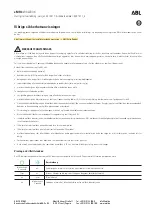
11-30
Maintenance and service
place all four tires.
T
Winter (snow) tires
Winter tires are best suited for driving on
snow-covered and icy roads. However
winter tires do not perform as well as sum-
mer tires and all season tires on roads oth-
er than snow-covered and icy roads.
Tire inspection
Check on a daily basis that the tires are
free from serious damage, nails, and
stones. At the same time, check the tires
for abnormal wear.
Contact your SUBARU dealer immediate-
ly if you find any problem.
NOTE
y
When the wheels and tires strike
curbs or are subjected to harsh treat-
ment as when the vehicle is driven on a
rough surface, they can suffer damage
that cannot be seen with the naked eye.
This type of damage does not become
evident until time has passed. Try not
to drive over curbs, potholes or on oth-
er rough surfaces. If doing so is un-
avoidable, keep the vehicle’s speed
down to a walking pace or less, and ap-
proach the curbs as squarely as possi-
ble. Also, make sure the tires are not
pressed against the curb when you
park the vehicle.
y
If you feel unusual vibration while
driving or find it difficult to steer the ve-
hicle in a straight line, one of the tires
and/or wheels may be damaged. Drive
slowly to the nearest authorized
SUBARU dealer and have the vehicle
inspected.
Tire pressures and wear
Maintaining the correct tire pressures
helps to maximize the tires’ service lives
and is essential for good running perfor-
mance. Check and, if necessary, adjust
the pressure of each tire (including the
spare) at least once a month (for example,
during a fuel stop) and before any long
journey.
Check the tire pressures when the tires
are cold. Use a pressure gauge to adjust
the tire pressures to the values shown on
the tire placard. The tire placard is located
on the door pillar on the driver’s side.
Driving even a short distance warms up
the tires and increases the tire pressures.
Also, the tire pressures are affected by the
outside temperature. It is best to check tire
pressure outdoors before driving the vehi-
cle.
When a tire becomes warm, the air inside
it expands, causing the tire pressure to in-
crease. Be careful not to mistakenly re-
lease air from a warm tire to reduce its
pressure.
NOTE
y
The air pressure in a tire increases
by approximately 4.3 psi (30 kPa, 0.3
kgf/cm
2
) when the tire becomes warm.
y
The tires are considered cold when
the vehicle has been parked for at least
three hours or has been driven less
than one mile (1.6 km).
800221
Do not let air out of warm tires to ad-
just pressure. Doing so will result in
low tire pressure.
Содержание 2006 Forester
Страница 3: ......
Страница 28: ...25 CONTINUED Tire changing tools 3 1 2 000132 1 Jack page 9 15 2 Jack handle page 9 15 3 Spare tire page 9 3 ...
Страница 91: ......
Страница 143: ...3 30 Instruments and controls Horn To sound the horn push the horn pad 300150 ...
Страница 145: ...4 2 Climate control Climate control Ventilator Air flow selection 400138 ...
Страница 164: ...Audio 5 7 CONTINUED noise when it receives calls This noise does not indicate a radio fault ...
Страница 225: ......
Страница 250: ...Driving tips 8 25 sion and shut off the engine ...
Страница 251: ......
Страница 267: ......
Страница 273: ......
Страница 316: ...Maintenance and service 11 43 CONTINUED Replacing bulbs 3 2 1 11 12 13 15 14 7 8 6 5 4 9 10 B00384 ...
Страница 345: ......
Страница 346: ...Index 14 ...
Страница 353: ......
Страница 354: ...10 9 8 7 6 5 4 3 11 12 13 000134 ...
















































